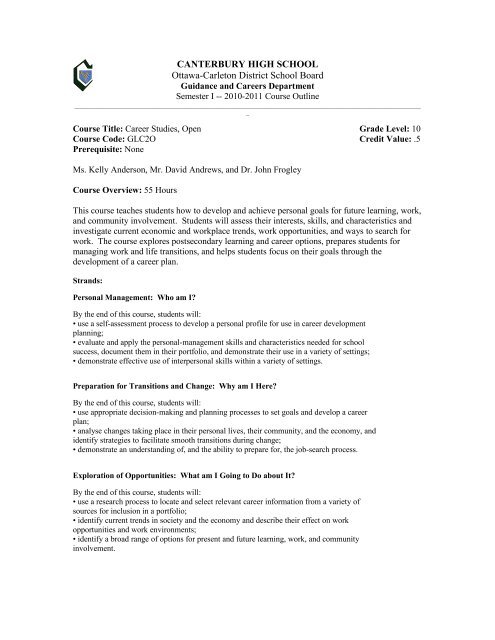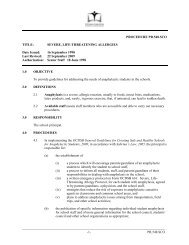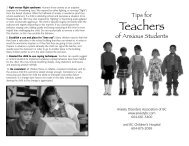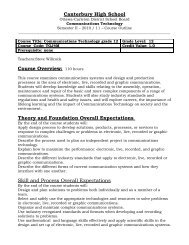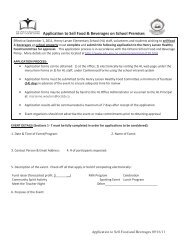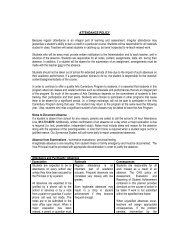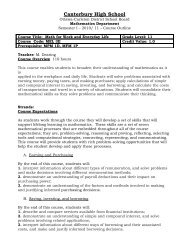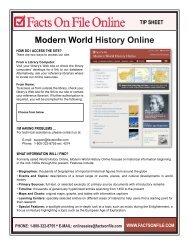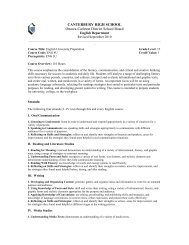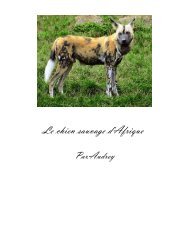Grade 10 Career Studies, GLC2O - Canterbury High School
Grade 10 Career Studies, GLC2O - Canterbury High School
Grade 10 Career Studies, GLC2O - Canterbury High School
Create successful ePaper yourself
Turn your PDF publications into a flip-book with our unique Google optimized e-Paper software.
CANTERBURY HIGH SCHOOL<br />
Ottawa-Carleton District <strong>School</strong> Board<br />
Guidance and <strong>Career</strong>s Department<br />
Semester I -- 20<strong>10</strong>-2011 Course Outline<br />
___________________________________________________________________________________________________________<br />
_<br />
Course Title: <strong>Career</strong> <strong>Studies</strong>, Open <strong>Grade</strong> Level: <strong>10</strong><br />
Course Code: <strong>GLC2O</strong> Credit Value: .5<br />
Prerequisite: None<br />
Ms. Kelly Anderson, Mr. David Andrews, and Dr. John Frogley<br />
Course Overview: 55 Hours<br />
This course teaches students how to develop and achieve personal goals for future learning, work,<br />
and community involvement. Students will assess their interests, skills, and characteristics and<br />
investigate current economic and workplace trends, work opportunities, and ways to search for<br />
work. The course explores postsecondary learning and career options, prepares students for<br />
managing work and life transitions, and helps students focus on their goals through the<br />
development of a career plan.<br />
Strands:<br />
Personal Management: Who am I<br />
By the end of this course, students will:<br />
• use a self-assessment process to develop a personal profile for use in career development<br />
planning;<br />
• evaluate and apply the personal-management skills and characteristics needed for school<br />
success, document them in their portfolio, and demonstrate their use in a variety of settings;<br />
• demonstrate effective use of interpersonal skills within a variety of settings.<br />
Preparation for Transitions and Change: Why am I Here<br />
By the end of this course, students will:<br />
• use appropriate decision-making and planning processes to set goals and develop a career<br />
plan;<br />
• analyse changes taking place in their personal lives, their community, and the economy, and<br />
identify strategies to facilitate smooth transitions during change;<br />
• demonstrate an understanding of, and the ability to prepare for, the job-search process.<br />
Exploration of Opportunities: What am I Going to Do about It<br />
By the end of this course, students will:<br />
• use a research process to locate and select relevant career information from a variety of<br />
sources for inclusion in a portfolio;<br />
• identify current trends in society and the economy and describe their effect on work<br />
opportunities and work environments;<br />
• identify a broad range of options for present and future learning, work, and community<br />
involvement.
Units of Study:<br />
Term<br />
Unit 1: Introduction<br />
(1 Week)<br />
Unit 2: Personal Exploration: Who am I (3 Weeks)<br />
Unit 3: Preparation for Transitions and Change: Why am I Here<br />
(3 Weeks)<br />
Summative<br />
Unit 4A: Exploration of Opportunities Presentation: What a m I Going to Do about It<br />
Unit 4B: Exploration of Opportunities Portfolio: What a m I Going to Do about It<br />
(3 Weeks)<br />
Teaching Strategies:<br />
A diversity of teaching strategies are used based on class interest, individual needs, student strengths,<br />
proven learning theory, and best practices. For example: discussions, presentations, videos,<br />
speakers, dramatic enactments, lectures, Internet research, interviews, role plays, fishbowls,<br />
movement, art, music, etc.<br />
Assessment and Evaluation Strategies<br />
A variety of assessment and evaluation strategies based on the provincial curriculum expectations and the achievement<br />
levels are used to improve student learning. They are varied in nature, administered over time, and are designed to<br />
provide opportunities for students to demonstrate the full range of their learning. They are not simply measurements of<br />
learning, but more importantly they are used for and as learning.<br />
Hence, term work is worth 70% of the student’s final mark composed of the Introduction, Personal Exploration Report,<br />
and Preparation for Transitions and Change Report.<br />
Summative work is worth 30% and is divided into two parts. The Exploration of Opportunities Presentation,<br />
worth 15%, showcases the student’s ability to critically and creatively integrate his or her learning, while the<br />
Exploration of Opportunities Portfolio, worth 15%, integrates three concurrent features of the course: Quotes of the<br />
Day, Team Exercises, and Guest Speakers.<br />
Evaluation Summary:<br />
The term work worth 70% is made up of three units equally weighted in terms of the Ministry’s KUTCA categories,<br />
and fully covering the three strands and addressing the expectations. A two-part summative worth 30% is composed of<br />
a presentation and portfolio.<br />
References<br />
Student Resources / Texts<br />
http://www.edu.gov.on.ca/eng/curriculum/secondary/guidance.html<br />
A variety of resources are used to give the students a rich learning experience.


